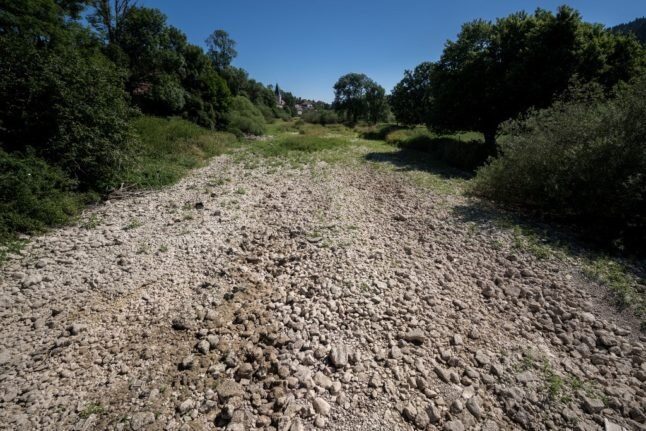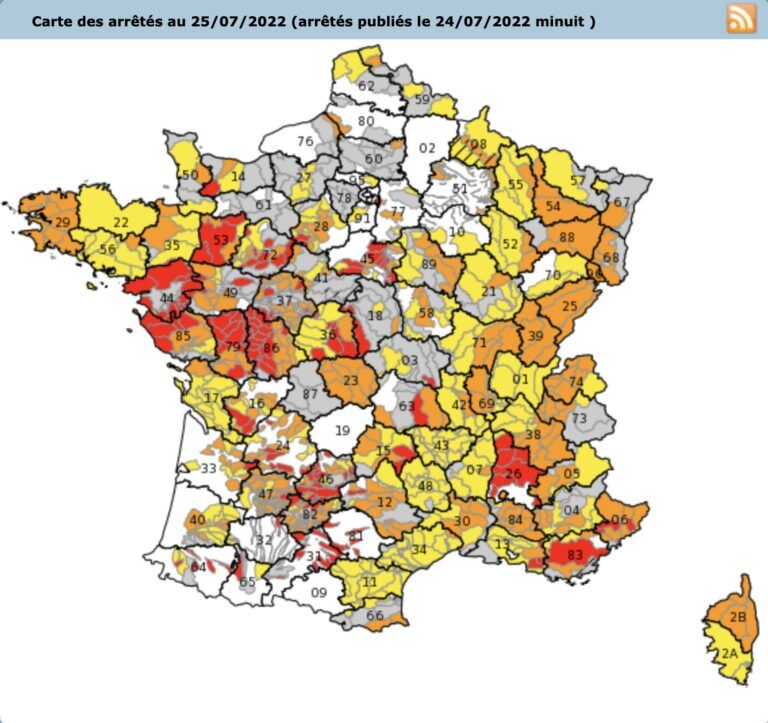Comment: It's exceptional, but it's not unprecedented, there have been others years where similar dry conditions have been recorded.
After record breaking heatwaves and forest fires across the country, most of France is now on drought alert.
Drought is impacting almost the entirety of the country from east to west. Of the 96 French mainland départements, 86 are currently on some level of drought alert, meaning there are restrictions on water usage in place.
There are four levels of alert, beginning with least to most severe: vigilance, alert (yellow), heightened alert (orange), and crisis (red).
Currently 28 départements are listed as in 'crisis' - the highest level of alert, with the regions of Centre-Val de Loire and Pays de la Loire appearing to be most severely impacted, as shown in the map below.
Even Brittany, a region that is not typically known for drought or hot temperatures, is seeing much of the region under at least the 'alert' or 'heightened alert' designation.
The east of the country is also heavily impacted, particularly mountainous areas in Isère.
A considerable part of France is on alert and heightened alert status, meaning water use is carefully controlled. Départements with yellow (alert) status must reduce water usage for agricultural purposes by up to 50 percent (or simply prohibit withdrawals up to three days per week).
'Yellow' level water restrictions do not only impact farmers - washing your car or watering your garden during the hottest hours of the day is forbidden under this alert, with some water activities also being restricted.
For those in orange départements, there are stronger limitations for watering gardens, green spaces, golf courses, and washing cars. In this scenario, farmers must reduce water usage for agricultural purposes by at least 50 percent or more.
Comment: It's odd that golf courses are included alongside industries as critical as farming. Because, what with these kinds of restrictions, harvest will be severely affected. And this comes amidst already looming global food shortages.
Even if this is and has been best practice for some time (and there's no information in the article to ascertain one way or the other) what with governments elsewhere imposing restrictions on farmers that will predictably harm production, and even throw farmers out of business, one can't help but be particularly suspicious as to whether the establishment's restrictions are purely motivated by the drought, or, at the very least, whether there couldn't be more appropriate prioritisation as to water usage:
- Farmer protests spread across the globe
- Canada's 35% tax penalty on Russian fertilizer imports is a disaster for local farmers
At crisis (red) level, all non-priority water withdrawals are halted - only water usage for health and hydration purposes are authorised.
Drought impacts everything from agriculture to tourism to even electricity production and the ability to cool nuclear reactors that power France.
Thus far, towns have seen their taps run dry and farmers worry about their animals, as creeks that once hydrated their livestock shrivel up. Tourists are also seeing the impacts of drought, particularly those in Charente-Maritime which has has banned outdoor beach showers to conserve water.
For farmers, there is also serious concern about this year's harvest. "The vines have started to wither, the grapes are no longer growing and the vines are completely blocked. If it doesn't rain, we're going to lose a lot of harvest," explained winegrower Cédric Chiapello to RTL. "With the heat wave and the drought falling at the same time, I think that this will also delay the harvest."
In order to cope with drought this summer in France, water agencies could spend up to an additional €100 million to help agricultural sectors adapt.
Experts once again blame the climate crisis. "The drought this year is clearly remarkable," said Florence Habets, hydroclimatologist and director of research at the CNRS to French daily Le Parisien. Soil moisture is at its lowest level in 60 years.
Comment: Lest we forget that soil's moisture retaining capabilities is also a result of agricultural practises, and, in the last 60 years, with tillage, compaction from modern machinery, as well as all of the pesticides, herbicides, and fertilizers currently in use, its ability to retain water has been significantly reduced. Therefore using soil moisture levels as a guide, or as 'proof', that the current weather is 'remarkable', is quite misleading. That said, the prolonged drought and the recurrent heatwaves are indeed abnormal.
The maps below show continued risk of drought across France from this point onward until the end of the summer, indicating much of the country will likely continue to be impacted.
There are some points of particular concern, such as the Serre-Ponçon lake, which is the largest water reservoir in the country. It is located at the crossroads of the Hautes-Alpes and Alpes-de-Haute-Provence départements, and its water levels have not been this low since its construction was completed in 1961. Currently, it is at six metres below optimal level.
Meanwhile, the National Federation of Fishing in France has launched a campaign to warn about the dangerous and continuous decline in river levels, which it believes is responsible for the disappearance of many species. "There has never been so much dryness in the rivers," said Loïc Obled, the deputy director general of the French Office of Biodiversity to Le Parisien.





Yahazqal (Ezekiel) 14:12-23 TS2009